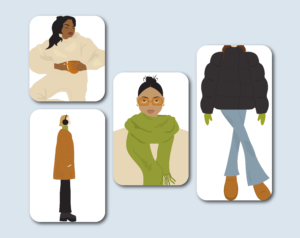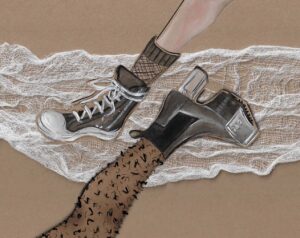GRAPHIC DESIGNER: IMANI EDWARDS
COPY EDITORS: HARLEEN GREWAL, EISHVINDER GILL
As someone who identifies as a “senior citizen” in the zoomer generation, I confronted TikTok with a bit of ambivalence. It’s a weird sense of estrangement, especially in a demographic that coin phrases like “not giving” and “cheugy” as everyday vernacular.
Fashion would act as a bridge, as I assumed that I would get familiar with the fast-paced nature of the platform by engaging in content that felt close to home. Honestly, I have yet to get accustomed to tricks in the TikTok trade. Fashion moves at a speed that’s whiplash-inducing.
According to Shopify, the average social media user spends 38 minutes on TikTok each day. Given that there are millions of profiles on the platform, it’s natural to assume that fashion brands are a significant piece of the pie. We’re exposed to thousands of new fads, current runway shows, influencer pages, and of course, up-and-coming clothing companies. Long-term consumption of media has the ability to influence our decisions and preferences, especially when it comes to fashion.
Low-rise bottoms are in; high-rise jeans are out. Matilda Djerf is the newest Kim Kardashian, and we should shame those that shop at Shein. The amount of do’s and don’ts declared by gatekeepers entails a lengthy list of trends and fads that disappear and reappear in a matter of days. It’s arguably convenient for trendsetters and forecasters looking to keep up on certain fads. That said, it doesn’t allow the current fashion industry enough time to breathe.


As you may have noticed, sustainability is fashion’s newest buzzword. Before the age of TikTok, fashionistas and regular dressers alike tried to become ethical shoppers. Timeless clothing became a hot commodity, clothing tags that provided transparent information about material sourcing and labor ethics were the norm, and the societal expectation to shun those who didn’t were prevalent. TikTok’s popularity seems counterintuitive to the sustainability movement, as it’s a platform that dictates the ins and outs at a rapid speed.
Hauls are a trending hashtag on the platform. Aside from Shein, thrifting is considered the in-thing among Zoomers, Millennials, and X-ers. According to an article published by Vogue, hashtags such as #thrifting and #vintage have amassed an astounding 8 billion views. While it’s easy to categorize second-hand shopping as a greener alternative to fast fashion websites, we shouldn’t confuse it with the ‘S’ word.
Sustainability and overconsumption are two sides of the same coin. If we conduct multiple thrift store hauls in a week, it does feed into our ecological footprint. What about the clothes you thrifted in the last month and the year before? Did you wear them at all? What happens to the garments that are unsold at second-hand shops?
These are pivotal questions that often go answered, as we’re blindsided by the ‘good-for-you’ nature posited by stores like Value Village and Goodwill.
Negativity aside, the popularity of TikTok does leave room for improvement and change. With the onslaught of fast fashion hauls and trend gatekeeping, some influencers are stepping up to the plate to address the problematic nature of unethical shopping. TikToker’s such as Blueland, Andrea Cheong, and Nihaelety produce content centered on environmentalism and the true meaning of sustainable fashion. For instance, Andrea Cheong offers an informational series on reviewing popular garments and brands like Zara and Reformation. She analyzes each piece or company based on product quality and timelessness. Nihaelety mainly focuses on activism concerning fast fashion as she calls out brands and practices that are controversial in the light of sustainability.
As a user who has disappointingly become trained to like TikToks that are less than 20 seconds, sitting through informational posts published by the likes of Blueland and Andrea Cheong is quite tasking. It’s relatively easy to swipe away, as the platform tends to celebrate nonsensical content over serious topics. That said, those unfamiliar with unethical shopping habits may find sustainable fashion as an eye-opener. The one thing that TikTok is excellent at pioneering is the ability to spread awareness on several topics. Additionally, today’s generation is quite avid in providing platforms for change-makers and activists while disempowering those that fall short.
If 5 seconds into a 3-minute review tackling the unethical labor practices of Zara is enough to change your perception, then I think it’s safe to say that social media has the potential to be a force of good.
























